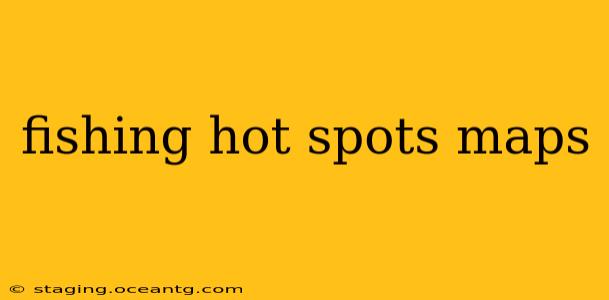Finding the perfect fishing spot can feel like searching for buried treasure. Luckily, technology and community resources have made it easier than ever to locate those coveted fishing hot spots. This guide dives into the world of fishing hot spot maps, exploring various resources, tips for using them effectively, and important considerations for responsible fishing.
What are Fishing Hot Spots?
Fishing hot spots are locations known for consistently producing good catches of fish. These areas often possess specific characteristics that attract fish, such as:
- Structure: Submerged structures like rocks, weed beds, sunken logs, and artificial reefs provide cover and attract baitfish, drawing in larger predatory fish.
- Depth Changes: Drop-offs, ledges, and channels create changes in water depth and current, concentrating fish.
- Baitfish Presence: Areas abundant in baitfish will naturally attract larger fish seeking a meal.
- Water Temperature: Fish prefer specific water temperatures, and hot spots often offer ideal thermal conditions.
- Current Flow: Strategic locations where currents converge or create eddies can be highly productive.
How to Find Fishing Hot Spots Maps?
Several excellent resources provide fishing hot spot maps, each offering unique advantages:
-
Online Mapping Services: Websites and apps like Google Maps, Navionics, and Fishidy often incorporate user-generated data, creating crowdsourced maps of popular fishing spots. These platforms allow users to share their catches, marking locations on the map for others to discover. Remember to always check the accuracy and reliability of user-submitted data.
-
Fishing Forums and Communities: Engaging with online fishing communities and forums can yield invaluable local knowledge. Experienced anglers frequently share their favorite spots and tips, though be mindful that some locations might be kept secret to preserve their productivity.
-
Local Tackle Shops and Bait Stores: These local businesses often possess detailed knowledge of local fishing conditions and productive spots. They can recommend specific locations, techniques, and even provide hand-drawn maps.
-
Fishing Guides and Charters: Hiring a local fishing guide is an excellent way to discover productive spots firsthand. Guides possess intimate knowledge of the area and can tailor their approach to the current conditions.
-
Nautical Charts: While not explicitly "hot spot maps," nautical charts provide essential information about water depth, structure, and navigation, allowing you to identify potentially productive areas based on underwater features.
What Information Do Fishing Hot Spots Maps Usually Show?
A comprehensive fishing hot spot map typically includes:
- Location Markers: Clearly marked locations of successful fishing spots, often categorized by species.
- Depth Contours: Lines indicating changes in water depth, crucial for identifying ledges, drop-offs, and channels.
- Structure Markers: Indicating underwater features like rocks, weed beds, and wrecks.
- Water Temperature Data: Sometimes includes real-time or historical water temperature data.
- User Reviews and Ratings: Allow other anglers to rate and review the productivity of different spots.
Are Fishing Hot Spot Maps Always Accurate?
While fishing hot spot maps are valuable tools, it's crucial to remember that their accuracy can vary. Several factors can influence their reliability:
- Time Sensitivity: Fishing conditions are dynamic; a productive spot today might be unproductive tomorrow due to weather changes, fish migration, or other factors.
- User-Generated Data: Maps relying on user-submitted data may contain inaccuracies or outdated information.
- Specificity: Maps may not always pinpoint the precise location but rather a general area.
Always use these maps as a starting point, and don't be afraid to explore surrounding areas to find your own personal fishing hot spots.
What are Some Tips for Using Fishing Hot Spot Maps Effectively?
- Verify Information: Don't solely rely on one source; cross-reference information from multiple maps and resources.
- Consider the Season: Fish migration patterns and preferred habitats change throughout the year. Adjust your search based on the season.
- Check Weather Conditions: Wind, rain, and temperature can significantly impact fishing conditions.
- Respect Other Anglers: Avoid overcrowding popular spots and be mindful of other anglers’ space.
- Practice Catch and Release: Consider employing catch and release techniques to ensure sustainable fishing practices.
What are the Best Apps for Fishing Hot Spots Maps?
Many apps offer fishing hot spot maps, each with its strengths and weaknesses. Some popular choices include Fishidy, Navionics, and Fishing Points. The best app for you will depend on your specific needs and preferences. Research different options and read reviews to find the best fit.
How to Create Your Own Fishing Hot Spots Map?
You can also create your own personal fishing hot spot map by tracking your successful fishing locations. Use a GPS device or a mapping app to record your coordinates, and add notes about the species caught, bait used, and fishing techniques. This personal database will become increasingly valuable over time.
Remember, responsible fishing is crucial. Always adhere to local regulations, practice catch and release when appropriate, and respect the environment. By combining the power of technology with traditional angling knowledge, you can unlock the secrets of countless fishing hot spots.
